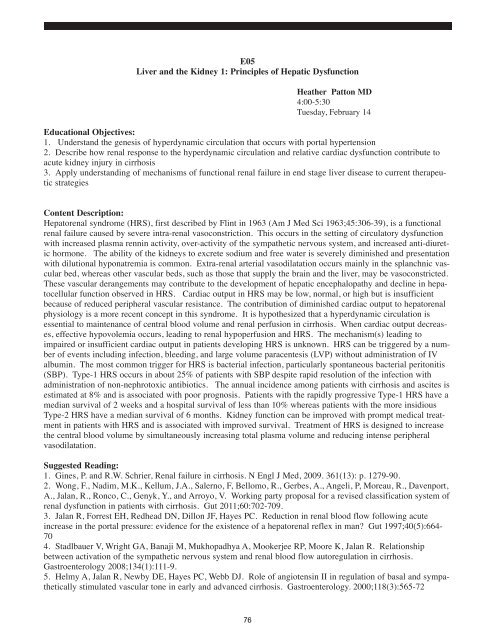ABSTRACTS from 16th International COnference on ... - CRRT Online
ABSTRACTS from 16th International COnference on ... - CRRT Online
ABSTRACTS from 16th International COnference on ... - CRRT Online
Create successful ePaper yourself
Turn your PDF publications into a flip-book with our unique Google optimized e-Paper software.
E05<br />
Liver and the Kidney 1: Principles of Hepatic Dysfuncti<strong>on</strong><br />
Heather Patt<strong>on</strong> MD<br />
4:00-5:30<br />
Tuesday, February 14<br />
Educati<strong>on</strong>al Objectives:<br />
1. Understand the genesis of hyperdynamic circulati<strong>on</strong> that occurs with portal hypertensi<strong>on</strong><br />
2. Describe how renal resp<strong>on</strong>se to the hyperdynamic circulati<strong>on</strong> and relative cardiac dysfuncti<strong>on</strong> c<strong>on</strong>tribute to<br />
acute kidney injury in cirrhosis<br />
3. Apply understanding of mechanisms of functi<strong>on</strong>al renal failure in end stage liver disease to current therapeutic<br />
strategies<br />
C<strong>on</strong>tent Descripti<strong>on</strong>:<br />
Hepatorenal syndrome (HRS), first described by Flint in 1963 (Am J Med Sci 1963;45:306-39), is a functi<strong>on</strong>al<br />
renal failure caused by severe intra-renal vasoc<strong>on</strong>stricti<strong>on</strong>. This occurs in the setting of circulatory dysfuncti<strong>on</strong><br />
with increased plasma rennin activity, over-activity of the sympathetic nervous system, and increased anti-diuretic<br />
horm<strong>on</strong>e. The ability of the kidneys to excrete sodium and free water is severely diminished and presentati<strong>on</strong><br />
with diluti<strong>on</strong>al hyp<strong>on</strong>atremia is comm<strong>on</strong>. Extra-renal arterial vasodilatati<strong>on</strong> occurs mainly in the splanchnic vascular<br />
bed, whereas other vascular beds, such as those that supply the brain and the liver, may be vasoc<strong>on</strong>stricted.<br />
These vascular derangements may c<strong>on</strong>tribute to the development of hepatic encephalopathy and decline in hepatocellular<br />
functi<strong>on</strong> observed in HRS. Cardiac output in HRS may be low, normal, or high but is insufficient<br />
because of reduced peripheral vascular resistance. The c<strong>on</strong>tributi<strong>on</strong> of diminished cardiac output to hepatorenal<br />
physiology is a more recent c<strong>on</strong>cept in this syndrome. It is hypothesized that a hyperdynamic circulati<strong>on</strong> is<br />
essential to maintenance of central blood volume and renal perfusi<strong>on</strong> in cirrhosis. When cardiac output decreases,<br />
effective hypovolemia occurs, leading to renal hypoperfusi<strong>on</strong> and HRS. The mechanism(s) leading to<br />
impaired or insufficient cardiac output in patients developing HRS is unknown. HRS can be triggered by a number<br />
of events including infecti<strong>on</strong>, bleeding, and large volume paracentesis (LVP) without administrati<strong>on</strong> of IV<br />
albumin. The most comm<strong>on</strong> trigger for HRS is bacterial infecti<strong>on</strong>, particularly sp<strong>on</strong>taneous bacterial perit<strong>on</strong>itis<br />
(SBP). Type-1 HRS occurs in about 25% of patients with SBP despite rapid resoluti<strong>on</strong> of the infecti<strong>on</strong> with<br />
administrati<strong>on</strong> of n<strong>on</strong>-nephrotoxic antibiotics. The annual incidence am<strong>on</strong>g patients with cirrhosis and ascites is<br />
estimated at 8% and is associated with poor prognosis. Patients with the rapidly progressive Type-1 HRS have a<br />
median survival of 2 weeks and a hospital survival of less than 10% whereas patients with the more insidious<br />
Type-2 HRS have a median survival of 6 m<strong>on</strong>ths. Kidney functi<strong>on</strong> can be improved with prompt medical treatment<br />
in patients with HRS and is associated with improved survival. Treatment of HRS is designed to increase<br />
the central blood volume by simultaneously increasing total plasma volume and reducing intense peripheral<br />
vasodilatati<strong>on</strong>.<br />
Suggested Reading:<br />
1. Gines, P. and R.W. Schrier, Renal failure in cirrhosis. N Engl J Med, 2009. 361(13): p. 1279-90.<br />
2. W<strong>on</strong>g, F., Nadim, M.K., Kellum, J.A., Salerno, F, Bellomo, R., Gerbes, A., Angeli, P, Moreau, R., Davenport,<br />
A., Jalan, R., R<strong>on</strong>co, C., Genyk, Y., and Arroyo, V. Working party proposal for a revised classificati<strong>on</strong> system of<br />
renal dysfuncti<strong>on</strong> in patients with cirrhosis. Gut 2011;60:702-709.<br />
3. Jalan R, Forrest EH, Redhead DN, Dill<strong>on</strong> JF, Hayes PC. Reducti<strong>on</strong> in renal blood flow following acute<br />
increase in the portal pressure: evidence for the existence of a hepatorenal reflex in man? Gut 1997;40(5):664-<br />
70<br />
4. Stadlbauer V, Wright GA, Banaji M, Mukhopadhya A, Mookerjee RP, Moore K, Jalan R. Relati<strong>on</strong>ship<br />
between activati<strong>on</strong> of the sympathetic nervous system and renal blood flow autoregulati<strong>on</strong> in cirrhosis.<br />
Gastroenterology 2008;134(1):111-9.<br />
5. Helmy A, Jalan R, Newby DE, Hayes PC, Webb DJ. Role of angiotensin II in regulati<strong>on</strong> of basal and sympathetically<br />
stimulated vascular t<strong>on</strong>e in early and advanced cirrhosis. Gastroenterology. 2000;118(3):565-72<br />
76
















